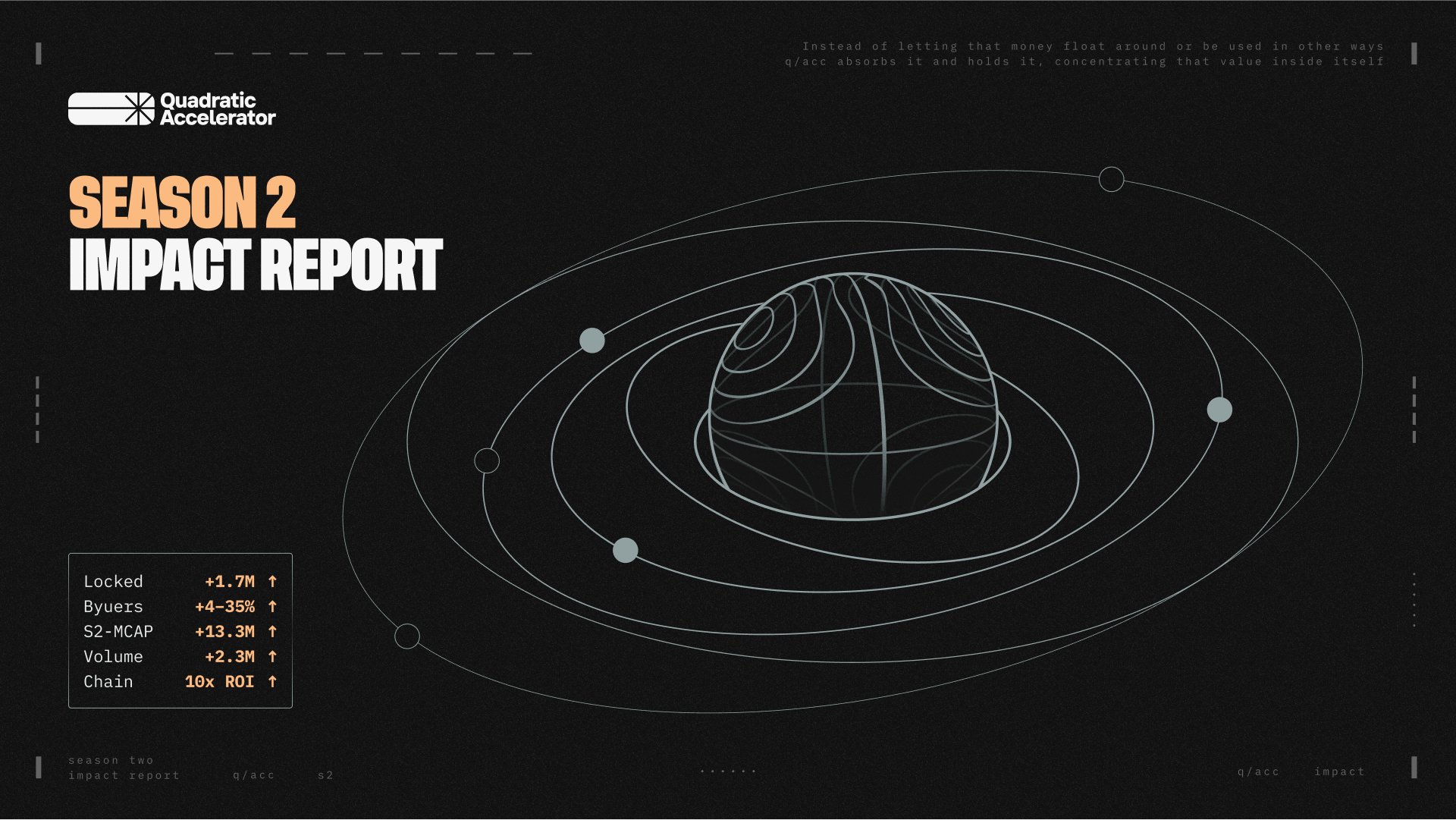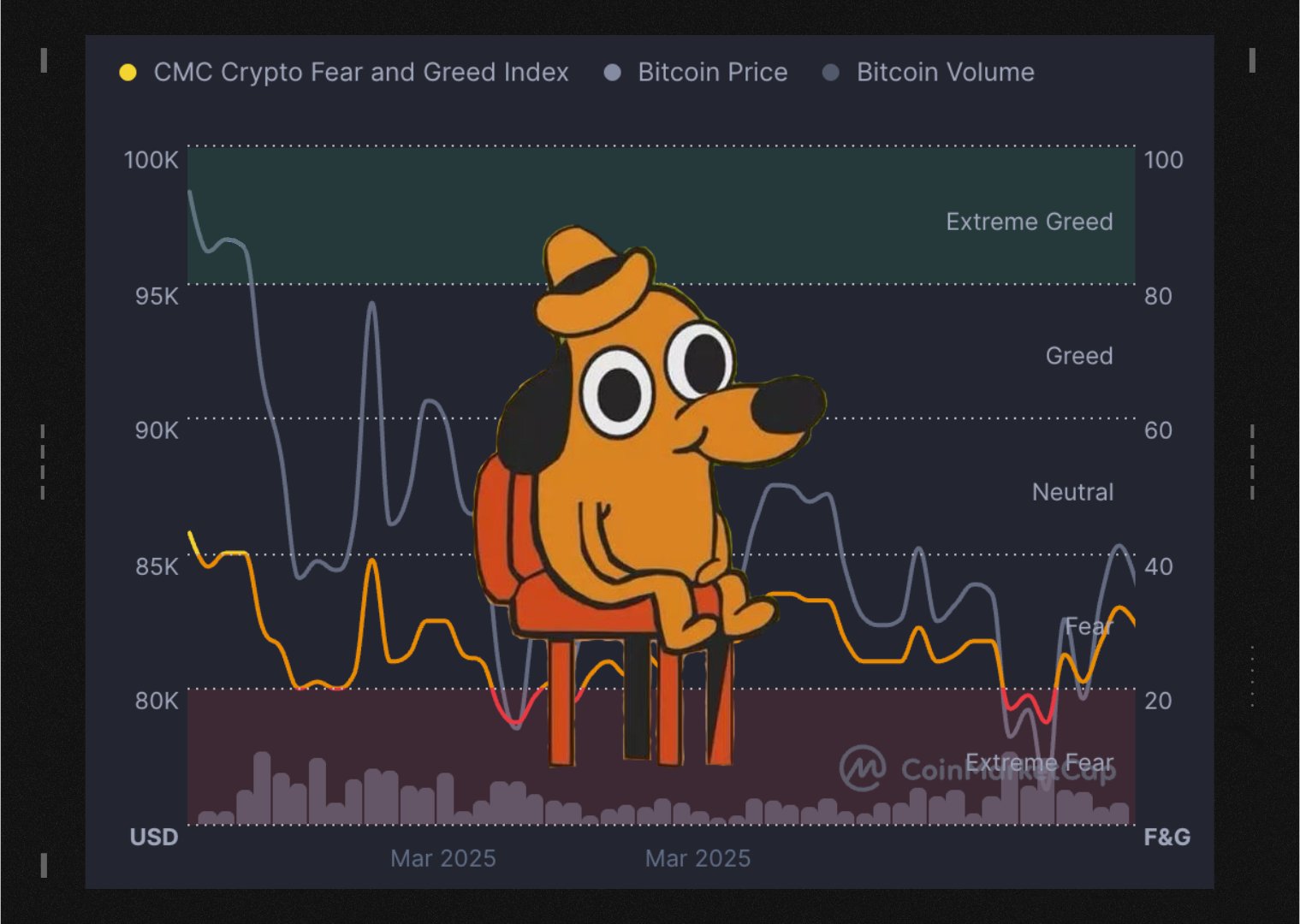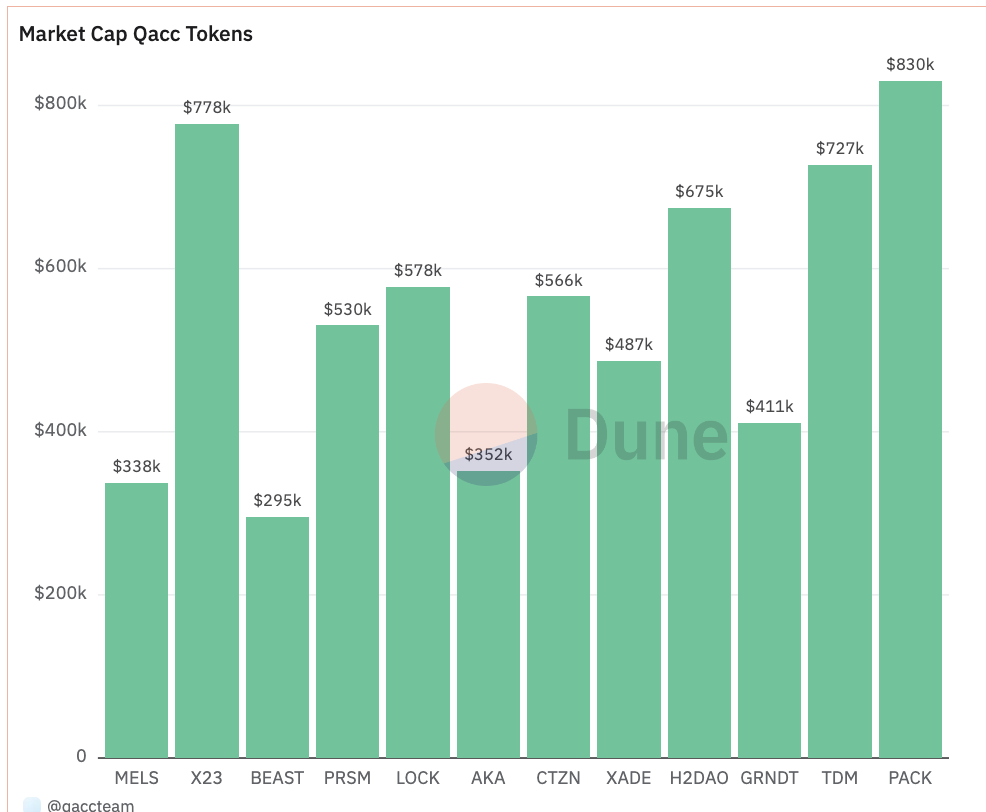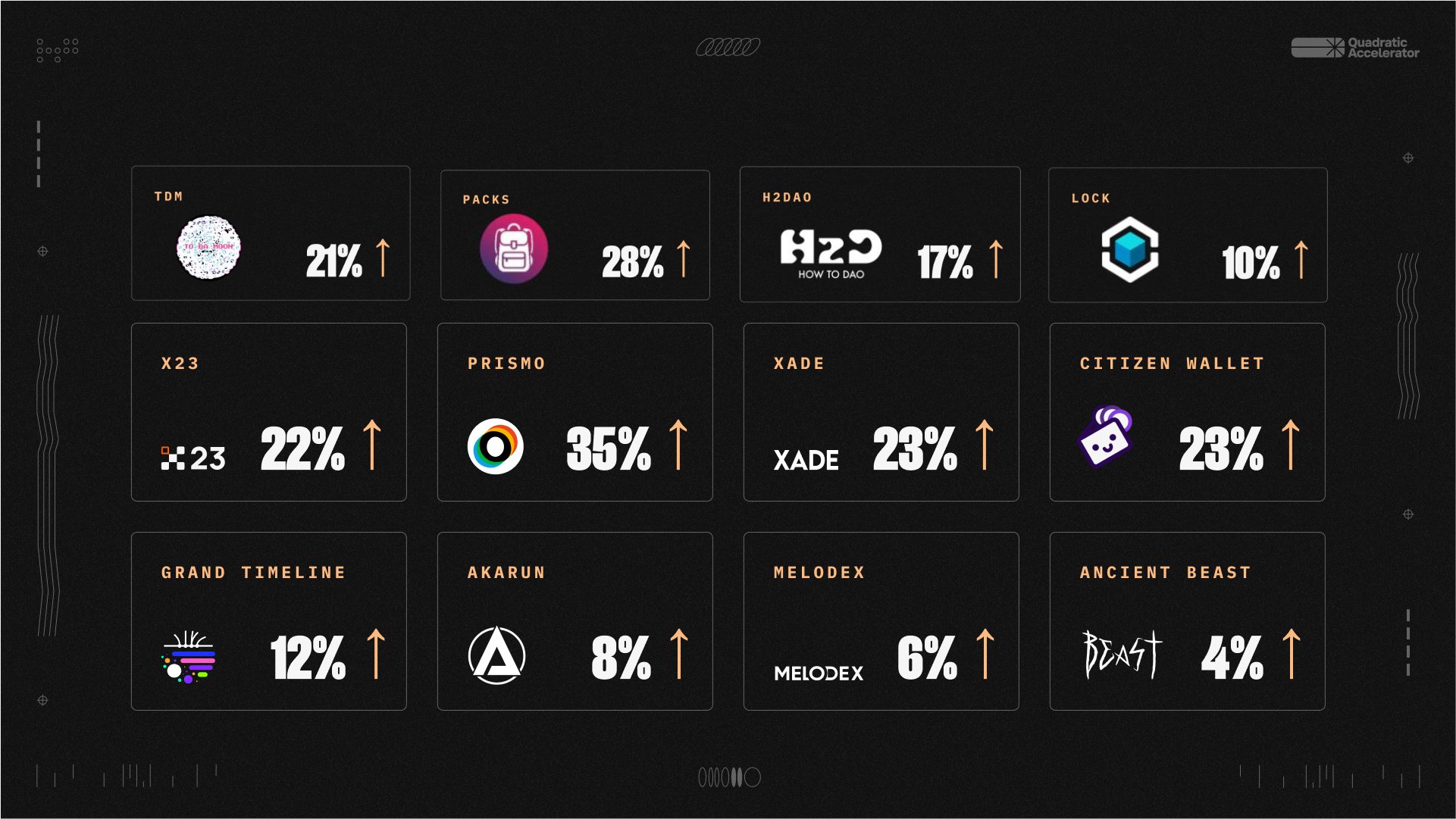Quadratic Accelerator S2 Impact Report
Introduction
The Quadratic Accelerator (q/acc) continues to redefine fair launch mechanics by combining Quadratic Funding with chain-sponsored Initial Coin Offerings (ICOs). In Season 2, sponsored by Polygon, we further refined our approach to ecosystem growth through protocol-sponsored tokenization (PST).
This report summarizes the S2 outcomes, highlights the performance of participating projects, and showcases how q/acc delivers compounding value to chains, builders, and token holders. See the results from S1 to get up to speed:
https://forum.polygon.technology/t/quadratic-accelerator-s1-impact-report/20893
Market Context
Season 2 was conducted during a challenging market period (April 29th - May 13th), with Bitcoin below $100k and Ethereum under $2k. We were coming from a yearly low marked by extreme fear. Despite these conditions, q/acc demonstrated remarkable resilience and produced compelling results that exceeded historic baseline norms.
S2 Cohort
Due to market conditions, we reduced our cohort size from 8 to 4 projects while maintaining the same quality bar. Each project received $50k POL in liquidity to launch their token, with additional matching pool distribution based on unique buyer participation. Here’s a brief recap of each S2 project:
To Da Moon
To Da Moon is the world’s first fully AI-generated sitcom set in Crypto City, where six chaotic characters have 30 days to launch a new Layer 2 chain—or implode trying. It’s The Office meets Silicon Valley… but written by AI, powered by prediction markets, and fueled by the drama we all know and love from Web3. Each AI agent runs in a trusted execution environment so no one truly knows what’s going to happen. See: q/acc profile and X account.
How To DAO
How To DAO is an educational program designed to introduce DAO’s to business professions. It’s based on the How To DAO book Published by Penguin Random House written to demystify the world of decentralized organizations. The book walks readers through the principles, architectures, and operational challenges behind DAOs — balancing philosophy with practical frameworks. It’s used by governance professionals, protocol founders, Web3 teams, and curious community members alike. See: q/acc profile and X account.
Gridlock
Gridlock is a self-custody crypto wallet that eliminates the need for seed phrases by employing Multi-Party Computation (MPC) and Distributed Key Generation. This approach splits your private key into multiple parts, distributing them across your devices and a network of trusted “Guardians.” Gridlock supports Bitcoin, Ethereum, Solana, as well as NFTs and is available on iOS and Android platforms and has over 10k downloads. See: q/acc profile and X account.
Web3 Packs
Web3 Packs simplifies crypto investing by offering curated, one-click portfolios that bundle tokens, liquidity positions, and yield strategies into a single transaction. Designed to reduce the complexity of managing assets across chains and dApps, Web3 Packs leverages Charged Particles technology to make diversified exposure to DeFi strategies, DAOs, and thematic investments accessible, no advanced knowledge or multi-step setup required. See: q/acc profile and X account.
Round Results
Like in S1, each project receives $50k to launch their token. This money goes into an augmented bonding curve, and then an open round is held where people mint that project’s new token. Another tranche of funds (the matching pool) is distributed to projects based on the number of individual unique buyers they attract. The more buyers a project has, the greater portion of the pool they receive and the larger their DEX liquidity pool is. S1 and S2 numbers are compared below, but let’s also consider some notable facets of the round.
Public Raise Ratio
If you look at the historical outcomes of prominent Quadratic Funding (QF) rounds, you’ll notice that the 20% ratio frequently arises. That is, 20% of the matching pool is often raised in additional funds from the public. By measuring in this way, we’re able to abstract away the exact size of each round. We’re happy to announce that S2 met and exceeded this baseline by raising the equivalent of 30% of the pool.
-
Raised 30% of the matching pool
-
Surpassed the historical 20% QF baseline
Standouts
Two projects did exceptionally well during the round regarding the amount raised and the number of minters. Web3 Packs raised over $20k, and To Da Moon attracted over 500 unique buyers. This is not to say the other projects have not done well. Over half of all projects launched by the q/acc program are more than halfway to a $1M market capitalization. See: Dune Dashboard
Exogenous Inflows
Another data point we’re excited to share is exogenous asset inflows. We introduced token and chain abstraction as a new feature in S2. Users could spend any token on any chain without leaving the app interface. This produced a new and compelling dynamic where we could measure sponsor token (POL) inflows from external sources—or, to put it more simply, “tokens dumped for POL.”
As you can see, over 65% of the funds raised came from competing protocols and ecosystems. This transparent swap introduces interesting vampire attack dynamics when extrapolated on a larger scale.
Total Stakeholder ROI
For Chains (Polygon)
The total return on grant expenditure for Polyon is unmatched in grant programs. Just like we did in S1, let’s compare what was put in vs. what was created for the chain:
1.5M POL came in, and instead of being dumped on the market, it grew to 1.7M POL. Then, that was used to cryptoeconomically create 13.3M POL net new market cap value across four teams, who are now creating millions in trading volume.
No other grant program produces results this direct.
For Buyers
The typical experience for people who acquire tokens as soon as they list or get an airdrop is a sudden and slow bleed-down from all-time highs. We hate this pattern and think end users do, too. That’s why we’ve ensured that tokens that launch through q/acc grow slowly and steadily after launch. All launched tokens enjoy a prolonged price floor relative to POL at the point of DEX listing, and buyers who get tokens during the actual q/acc round get them at a sharp discount. Initially focusing exclusively on S2 teams, buyers enjoyed a 10% to 28% appreciation compared to current prices.
Most S1 teams have seen even better growth as their tokens have gained market adoption. All projects have netted buyers returns between 4%-35% at today’s prices and this after the significant market downturns already noted:
For Teams
Each S2 team now owns a liquid token economy worth $0.5M-$0.7M. These tokens can be used for BD and deeply integrated into product functionality. Teams now have a whole new set of strategic options to leverage. They have more levers to pull and many of them are already leveraging them by introducing premium features exclusive to token holders. They received this in a turn-key fashion without the cost of a legacy token launch.
Conclusion
Our core thesis stands: Tons of small-to-medium-sized protocols (SMPs) would benefit from tokenization but are priced out. Chains have a opportunity to onboard these teams through sponsored launches via q/acc.
Chains want adoption. Projects want economies. Communities want upside. The q/acc program aligns all three.
X Thread: https://x.com/theqacc/status/1932770273012691181
Mirror Post: https://mirror.xyz/qacc.eth/1SXFKQM2Ea81s8BqDy6C4qSk2P-rf2qzdIkmoZbCLyQ






